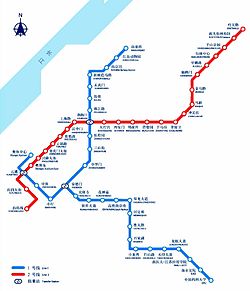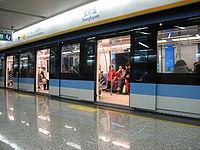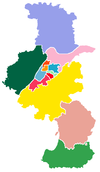- Nanjing Metro
-
Nanjing Metro 
Info Locale Nanjing Transit type Rapid transit Number of lines 2 Number of stations 55 exc. transfers Daily ridership 0.71 million (2010) Annual ridership 146 million (2009) [1] Operation Began operation September 2005 Number of vehicles Alstom
MetropolisTechnical System length 87.0 km (54.1 mi) Track gauge 1,435 mm (4 ft 8 1⁄2 in) (standard gauge) System map Nanjing Metro Simplified Chinese 南京地铁 Traditional Chinese 南京地鐵 Transcriptions Mandarin - Hanyu Pinyin Nánjīng Dìtiě The Nanjing Metro is a metro system serving the city of Nanjing, Jiangsu, China. It first opened in 2005, and as of 2011, there are two lines in operation, with 87.0 km (54.1 mi) of track in operation.
Contents
Current system
Line Terminals Opened Newest
extensionLength
(km)Stations Interchanges 1 Maigaoqiao Olympic Stadium East 2005 2010 46.2 31 2 China Pharmaceutical University 2 Youfangqiao Jingtianlu 2010 - 40.8 26 2 Total: 87.0 57 [2] Line 1
Main article: Line 1, Nanjing MetroLine 1 is 46.2 km long and has 31 stations. It runs mainly in a north-south direction. The line starts at Maigaoqiao station in the north, heading southwards until it splits at Andemen Station, from where the main line heads westwards towards Olympic Stadium Station, while the branch line continues southwards to CPU Station (China Pharmaceutical University).
The construction of Line 1 began in the year 2000 and was inaugurated on September 3, 2005, with 16 stations and a length of 21.72 km.[3]
On May 28, 2010, Line 1's 24.5 km-long south extension entered into operation.[4][5]
Line 2
Main article: Line 2, Nanjing MetroLine 2 is 40.8 km long and has 26 stations. It runs mainly in a east-west direction, from Youfangqiao Station in the southwest to Jingtianlu Station in the northeast. It entered into operation on May 28, 2010. [4][6]
Future expansion
According to the latest report, the Nanjing Municipal Government plans to complete 17 lines by 2030.[7]
Line 1
A west extension line which will go across the Yangtze River is currently under construction. This line will be approximately 14.4 km in length with 8 stations.[8]
Line 3
Groundbreaking works for Line 3 has started in January 2010. This new line, with a north-south orientation, will be approximately 40.19 km in length with 28 stations.[9]
Nanjing Metro Blueprint 2030
Ticket system
Like many metro systems in the world, fares on the Nanjing Subway are distance-based. Fares range from 2 yuan (approx USD $0.30) for journeys under 8 stations, to 4 yuan for longer journeys. There is a 5% discount for users of the Nanjing Public Utility IC Card.
Single tickets
Single journey tickets can be purchased from the ticket vending machine or at a ticket window. The ticket vending machine accepts both coins and bills (¥5 and ¥10).
Transit Card
Apart from one-way tickets, fares can also be paid with the Nanjing Public Utility IC Card, or Jinlintong (Chinese: 金陵通; pinyin: Jīnlíngtōng). It can be purchased for a refundable fee of 25 yuan (about 3.8 dollars) and refilled at ticket booths inside the metro stations as well as many collaborative convenience stores throughout the city. The card can also be used to pay for other means of public transportation, such as the city taxi and the city bus.
This transit card is similar to Beijing's Yikatong, Chicago Card of the CTA, the SmarTrip of the Washington Metro, and the Octopus card of Hong Kong's MTR.
Rolling stock
- 20 six-car Alstom/Nanjing Puzhen Rolling Stock Works Metropolis sets - ordered in 2002 for Line 1 opening.[3]
- 21 six-car Alstom/Nanjing Puzhen Rolling Stock Works Metropolis ordered January 2008 for Line 1 extension.[4]
- 144 Alstom/Nanjing Puzhen Rolling Stock Works Metropolis cars ordered 2007 for Line 2.[10]
Signaling System
For Line 1, Siemens Transportation Systems (TS) was awarded the supply contract in November 2002.
For Line 2, Siemens Transportation Systems (TS) and its local partner Nanjing Research Institute of Electronic Technology (NRIET) have been awarded to supply the signaling system after signing a contract (about 25 million Euro). Technologies used include Trainguard MT, Vicos OC 501, Sicas ECC and Az S 350 U axle counting system.[11]
See also
References
- ^ "Blog Archive » Nanjing Metro New Developments". DailyDOOH. 2009-08-08. http://www.dailydooh.com/archives/14286. Retrieved 2010-10-14.
- ^ This figure involves counting the two interchanges once for every line that it is part of. If every interchange is only counted once, there will be 55 stations.
- ^ a b "Nanjing metro inaugurated". Railway Gazette International. 2005-10-01. http://www.railwaygazette.com/news/single-view/view//nanjing-metro-inaugurated.html.
- ^ a b c "Nanjing Metro places €85·5m train order". Railway Gazette International. 2008-01-25. http://www.railwaygazette.com/news/single-view/view//nanjing-metro-places-EUR855m-train-order.html.
- ^ 南京地铁二号线载人模拟运营, Sina News. Retrieved 25 May 2010.
- ^ 南京地铁二号线载人模拟运营, Sina News. Retrieved 25 May 2010.
- ^ 南京轨道交通线网共17条; Retrieved 6 March 2010.
- ^ 南京地铁三号线暨一号线西延过江线试验段开工; Retrieved 25 May 2010.
- ^ 南京地铁三号线开工; Retrieved 6 March 2010.
- ^ "Shanghai and Nanjing order cars". Railway Gazette International. 2007-06-01. http://www.railwaygazette.com/news/single-view/view//shanghai-and-nanjing-order-cars.html.
- ^ "Siemens to supply advanced signaling and control systems to Nanjing Metro Line 2". Siemens AG. 2007-04-20. http://cn.siemens.com/cms/cn/english/ts/press/presscontent/Pages/2007_04_20.aspx. Retrieved 2008-06-30.[dead link]
External links
- UrbanRail.net's page on the Nanjing Metro
- Nanjing Metro official site (in Chinese)
- Alstom wins contract
Nanjing Metro Lines in operation Main LineMaigaoqiao • Hongshan Zoo • Nanjing Railway Station • Xinmofanmalu • Xuanwumen • Gulou • Zhujiang Road • Xinjiekou • Zhangfuyuan • Sanshan Street • Zhonghuamen • Andemen • Xiaohang • Zhongsheng • Yuantong • Olympic StadiumSouthern
ExtensionMaigaoqiao • Andemen • Tanglongsi • Ruanjiandadao • Huashenmiao • CRH Nanjing South Railway Station • Shuanglongdadao • Hedingqiao • Shengtailu • Baijiahu • Xiaolongwan • Zhushanlu • Tianyindadao • Longmiandadao • NMU • NJCI • CPUYoufangqiao • Yurundajie • Yuantong • Olympic Stadium East • Xinglongdajie • Jiqingmendajie • Yunjinlu • Mochouhu • Hanzhongmen • Shanghailu • Xinjiekou • Daxinggong • Xi'anmen • Minggugong • Muxuyuan • Xiamafang • Xiaolingwei • Zhonglingjie • Maqun • Jinmalu • Xianhemen • Xuezelu • Xianlinzhongxin • Yangshangongyuan • NJU Xianlin Campus • JingtianluLines under construction 3Planned lines 4 • 6 • 10 • 12 • 15 • 16 Rapid transit in the People's Republic of China
Rapid transit in the People's Republic of ChinaMRT & LRT In operationBeijing (Beijing • Beijing Suburban) • Changchun • Chengdu • Chongqing • Dalian (Dalian • Dalian Trams) • Guangzhou-Foshan (Guangzhou • Foshan) • Hong Kong-Shenzhen (Hong Kong • Shenzhen • Hong Kong LRT) • Nanjing • Shanghai (Shanghai • Shanghai Maglev • Zhangjiang Tram) • Shenyang • Tianjin (Tianjin • Binhai • TEDA Tram) • Wuhan • Xi'anUnder constructionPlannedChangzhou • Datong • Huizhou • Hohhot • Jiaxing • Jinan • Lanzhou • Quanzhou • Shijiazhuang • Taiyuan • Weifang • Wenzhou • Xiamen • Xuzhou • ZiboBRT In operationHangzhou • Beijing • Kunming • Changzhou • Xiamen • Jinan • Zaozhuang • Zhengzhou • Guangzhou • Dalian • Chongqing • HefeiUnder constructionShanghai • Shenzhen • Wuxi • Xi'an • Shenyang Transport in the People's Republic of China •
Transport in the People's Republic of China •  Rail transport in the People's Republic of ChinaCategories:
Rail transport in the People's Republic of ChinaCategories:- Nanjing Metro
- Rapid transit in China
- Transport in Nanjing
- Siemens Transportation Systems projects
- Railway lines opened in 2005
Wikimedia Foundation. 2010.







